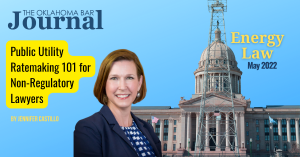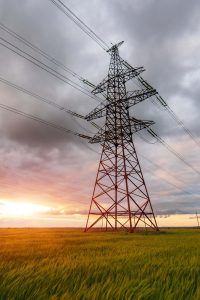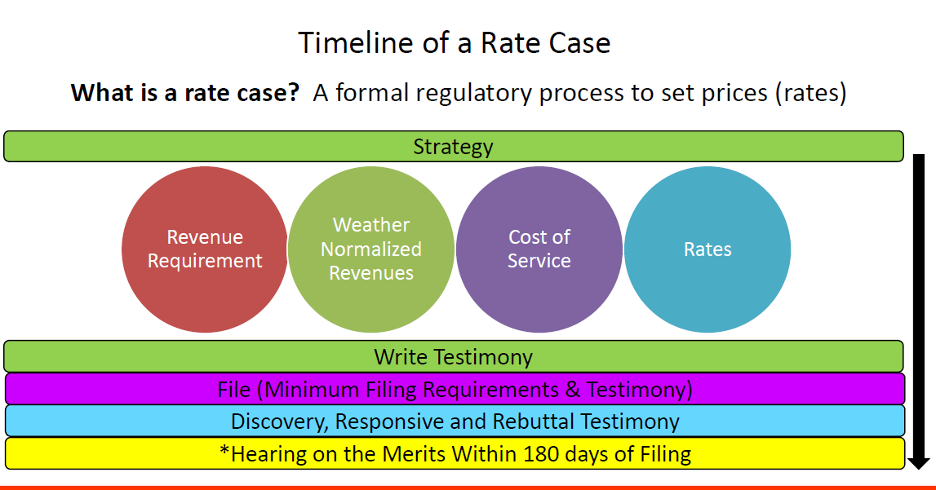Oklahoma Bar Journal
Public Utility Ratemaking 101 for Non-Regulatory Lawyers
By Jennifer Castillo
 The news has been full of storiesdetailing the impact of unforeseen events, such as worldwide pandemics, extreme weather events and international conflicts on particular industries. For example, a CNN business article dated March 13 discusses the impact of the conflict between Ukraine and Russia on American gasoline prices. “Why are US gas prices soaring when America barely uses Russian oil?” asks Julianne Pepitone, CNN Business. But have you ever stopped to consider the impact of similar events on your electric utility bills?
The news has been full of storiesdetailing the impact of unforeseen events, such as worldwide pandemics, extreme weather events and international conflicts on particular industries. For example, a CNN business article dated March 13 discusses the impact of the conflict between Ukraine and Russia on American gasoline prices. “Why are US gas prices soaring when America barely uses Russian oil?” asks Julianne Pepitone, CNN Business. But have you ever stopped to consider the impact of similar events on your electric utility bills?
In contrast to prices charged by private, non-regulated companies for their products and services, prices charged by public utilities must be reviewed and approved by the state regulatory agency whose responsibility it is to oversee prices, called rates, charged by public utilities. In Oklahoma, the Oklahoma Corporation Commission is the regulatory agency charged with the general authority to review and approve the costs charged by a public utility operating in Oklahoma.1 The purpose of this article is to provide a brief description of public electric utility rate cases, the legal framework behind them, the public policy supporting them, as well as an overview of the ratemaking process, including a note on the specific circumstances that led to the filing of rate cases to recover the extreme costs incurred by public utilities during Winter Storm Uri in February 2021.

Yelantsevv | #352946773 | stock.adobe.com
THE OKLAHOMA CORPORATION COMMISSION HAS AUTHORITY TO REVIEW AND APPROVE PUBLIC UTILITY RATES
“Utilities are given the privilege of providing services on an essentially monopolistic basis and are therefore subject to regulation by the Oklahoma Corporation Commission.”2 Specifically, Article 9 of the Oklahoma Constitution grants the Oklahoma Corporation Commission (“Commission” or “Corporation Commission”) broad authority to supervise, regulate and control all “public service corporations, including … all gas, electric, heat, light and power companies, and all persons, firms, corporations, receivers or trustees engaged in said businesses, … and all persons, firms, corporations, receivers and trustees engaged in any business which is a public utility.”3 Art. 9, Section 18 also grants the Corporation Commission the authority to promulgate and enforce rules, regulations and requirements, as well as the authority to prescribe and enforce rates, charges and classifications of traffic. The Corporation Commission’s authority to set rates for public utilities “is paramount,” and its authority to establish other rules and regulations is subject only to the Legislature’s authority as prescribed by statute.4
Title 17 of the Oklahoma Statutes governs the Corporation Commission and beginning at Section 151, further delineates the Corporation Commission’s jurisdiction and authority over public utilities.5 Section 152 of Title 17 further defines the Corporation Commission’s general supervision and jurisdiction over public utilities and particularly provides that the Corporation Commission, comprised of three commissioners elected to serve six-year terms,6 has “power to fix and establish rates and to prescribe and promulgate rules, requirements and regulations, affecting their services, operation, and the management and conduct of their business …”7
RATE CASES AND RATEMAKING
The prices regulated electric utilities charge in exchange for providing customers with electricity are determined through an open, public process called a rate case. Rate cases seek to balance the needs of customers and the public electric utility with the specific public policy goal of ensuring Oklahomans have safe, reliable electric service at reasonable rates.8During a rate case, the reasonable costs for the public utility to provide electric service are determined, and the amount of money the utility will collect through rates to provide that service in a safe and reliable manner is calculated. This process of establishing rates of payment is known as “ratemaking.”
Rate Case Application Package
When a public electric utility operating in Oklahoma wants to increase its rates, it must file an application for a general rate change with the Oklahoma Corporation Commission.9 Such applications “shall be given immediate attention” by the Corporation Commission.10 Along with the application, a public utility seeking a rate change must also submit substantial documentation to establish the utility’s costs and to support the rationale behind the requested rate increase “application package.”11The supporting documentation contained in an application package generally includes the utility’s costs of labor; costs of materials, including fuel and purchased power;12 taxes and depreciation on the plant used to deliver services, as well as the interest for debt issued by the utility to finance construction of that plant and a proposed reasonable return on investment made by the shareholders.13 These amounts added together are the revenue requirement the public utility wants to collect from its customers in the form of future billings.14 Only costs determined to be reasonable and prudent by the Corporation Commission are allowed to be included in the revenue requirement.15
The application package should also contain supporting documentation of the utility’s proposed rate design. The goal is to design a rate that allows the public utility to recover its revenue requirement, is “weather normalized”16 and appropriately allocates the revenue requirement among the different groups or classes of utility customers, such as residential, industrial and commercial, based on the reasonable cost of such service and in a non-discriminatory manner.17 Other goals of a particular rate design may be to encourage resource conservation or ensure a rate charged to a particular class of customers is consistent with the costs of providing such service.18 The goals and reasoning in support of a particular rate design are explained in written testimony included in the application package.
Notice Requirements
Once a public utility has filed an application package seeking a rate increase, it is required to make a “good faith” effort to serve notice of the rate case on all affected utility customers.19 Notice of any hearing on the application must also be published “once a week for two (2) consecutive weeks at least fifteen (15) days prior to hearing in a newspaper of general circulation published in each county in which are located utility customers affected thereby, unless the Commission directs otherwise.”20
Represented Interests and Public Involvement
The Public Utility Division staff (PUD staff) of the Corporation Commission has 120 days from the date of filing to complete its examination of the application package.21This 120-day examination period is essentially the discovery phase and includes the exchange of data requests and responses between the utility and PUD staff, as well as the filing of testimony responsive to the application package by PUD staff.22The utility also has the opportunity to file rebuttal testimony.23
The Office of the Oklahoma Attorney General (AG) is also a party to rate cases and represents the interests of residential customers.24 During the 120-day period, the AG may request information from the utility regarding the revenue requirement and/or rate design and file written testimony and/or statements of position responding to the application package.25 Over the past few decades, other parties representing a particular class of customer or special interest group have begun intervening in rate cases, which is permitted by OAC 165: 5-7-61. During the 120-day period, the utility also works actively to resolve as many issues as possible with PUD staff, the AG and intervenors. Customers and the general public are also permitted to file comments voicing concerns.26
Public Hearing Requirements and Issuance of a Final Order
If the public utility is unable to resolve all issues with PUD staff, the AG and any intervenors, the Corporation Commission will resolve them in an order to be issued after the public hearing.2728This public hearing can be handled by an administrative law judge (ALJ) or the commissioners sitting en banc and must commence within 45 to 180 days of the end of the PUD staff’s examination period.29 At the public hearing, witnesses who filed written testimony are made available for cross-examination on their positions.30 Members of the public are also allowed an opportunity to make oral comments.
 At the conclusion of the public hearing, when evidence supporting the positions of the various parties has been filed of record and heard, the ALJ issues and files a written report and recommendation with the Commission. The report and recommendation contain the procedural history of a rate case, a summary of each witness’s written testimony and cross-examination, findings of fact and the recommended rate to be integrated into the public utility’s customer billings. The commissioners sitting en banc deliberate and vote on the report and recommendation of the ALJ at an open meeting and ultimately issue an order setting forth the approved rate.
At the conclusion of the public hearing, when evidence supporting the positions of the various parties has been filed of record and heard, the ALJ issues and files a written report and recommendation with the Commission. The report and recommendation contain the procedural history of a rate case, a summary of each witness’s written testimony and cross-examination, findings of fact and the recommended rate to be integrated into the public utility’s customer billings. The commissioners sitting en banc deliberate and vote on the report and recommendation of the ALJ at an open meeting and ultimately issue an order setting forth the approved rate.
If, however, the Corporation Commission has not completed its examination and issued a final order within the 180-day statutory period, 17 O.S. §152 authorizes a public utility to put into immediate effect and collect “some or all of the request for changes in rates, charges, and regulations” on an interim basis.31
If the Corporation Commission, after completing its examination of the public utility’s rates and charges, determines a refund of the interim rate is appropriate and necessary, the Commission “shall order such refund including a reasonable interest at the one-year U.S. Treasury bill rate accruing on that portion of the rate increase being refunded for a period not to exceed ninety (90) days from the date of the rate increase being refunded.”32
IMPACT OF WINTER STORM
URI ON ELECTRIC PUBLIC UTILITY RATES IN OKLAHOMA
Winter Storm Uri is the name given to the widespread winter weather storm that descended across a large part of the United States and into parts of Mexico in February 2021. Uri swept in fast, causing historic winter freezing weather and resulting in winter weather alerts, power outages and North American Electric Reliability Corporation33 (NERC) reliability events across Oklahoma and other neighboring states, such as Texas and Arkansas.
Specifically, the unprecedented low temperatures and extensive ice storms brought rapid well and pipeline freezes to an extent not seen before, resulting in a shortage of natural gas. The shortage of natural gas deprived the entire natural gas market of large quantities of gas, leading to widespread power curtailments and blackouts in Texas, as well as never before experienced prices across the region. In fact, Uri is credited with causing the largest U.S. power outage since the outage that occurred in the upper Northeast in 2003 that resulted in a blackout affecting an estimated 50 million people.34 Due to the recurrence of below-freezing temperatures for multiple days, the impact of Uri was felt in Oklahoma from Feb. 13 to Feb. 21, 2021.
Executive Order No. 2021-06
On Feb. 12, 2021, Oklahoma Gov. Kevin Stitt issued Executive Order No. 2021-06, in which he declared a statewide emergency due to “extreme freezing temperatures and severe winter weather including snow, freezing rain, and wind beginning February 7, 2021, and continuing.” In his declaration, Gov. Stitt further stated, “There is hereby declared a disaster emergency caused by severe winter weather in all 77 Oklahoma counties that threatens the public’s peace, health and safety.” The Corporation Commission subsequently entered two emergency orders related to Uri and resulting conditions on limited gas supply, prioritization of electric and gas service for public health, welfare and safety and the need for conservation efforts.
Because demand for natural gas escalated dramatically due to the consequences of Uri, natural gas markets across the region experienced a profound crisis. Wholesale electricity prices also experienced unprecedented increases in cost due to the unusually high natural gas prices. Costs incurred by public electric utilities for fuel and wholesale electricity are normally passed to customers through a Fuel Cost Adjustment Rider (FCA).35 However, the cost of natural gas during Uri significantly exceeded the entire amount budgeted for fuel and purchased power by some public utilities in 2020, which would have resulted in a burdensome outcome to ratepayers.
Oklahoma Regulated Utility Consumer Protection Act
To address this issue, the Oklahoma Legislature drafted the Regulated Utility Consumer Protection Act,36 enacted by Gov. Stitt on April 23, 2021. This allowed affected public utilities to securitize the right to recover “extreme purchase costs”37 associated with Uri from Feb. 7 to Feb. 21, 2021. The act also permits issuance of bonds to enable customers to pay costs associated with Uri at a lower annual over a longer period of time.
Pursuant to the act, several public utilities in Oklahoma requested permission to defer all recovery fuel and purchased power costs as amortized over a longer and more manageable period of time. In response, the Corporation Commission allowed amortization of the extraordinary costs of Uri over a period of 10 years.38
CONCLUSION
Winter Storm Uri, which struck a large portion of the United States with freezing precipitation and below-freezing temperatures, caused wellhead and pipe freezing that ultimately resulted in numerous outages, as well as the implementation of curtailment measures. Another result was the extreme increase in natural gas and wholesale electric prices across the region. Rather than simply pass the extraordinary costs caused by Uri through a general rate increase, which would have been a hardship on Oklahoma utility customers, public electric utilities have taken advantage of the Regulated Utility Consumer Protection Act.39As a result, Oklahoma consumers will be impacted less due to the ability to amortize the costs of Uri over a longer period of time.
ABOUT THE AUTHOR
 Jennifer Castillo is a senior attorney, manager RIM at OGE Energy Corp. She earned her J.D. from the OCU School of Law in 2002 and will complete an LL.M. in litigation management from Baylor Law School in June 2022.
Jennifer Castillo is a senior attorney, manager RIM at OGE Energy Corp. She earned her J.D. from the OCU School of Law in 2002 and will complete an LL.M. in litigation management from Baylor Law School in June 2022.
- Public utilities in Oklahoma include Oklahoma Gas and Electric Company, Liberty Utilities (formerly Empire District Electric Co.), Public Service Co. of Oklahoma, Oklahoma Natural Gas, Summit Utilities Oklahoma Inc. and Arkansas-Oklahoma Gas Corp. A complete list of electric, gas, water, cotton gin and telecommunication companies designated as public utilities can be found on the Oklahoma Corporation Commission website at https://bit.ly/3x3pkfz.
- Sierra Club v. Corporation Commission, 2018 OK 31, ¶19, 417 P.3d 1196 (Okla. 2018).
- Okla. Const., Art. 9, §§18, 34.
- 2018 OK 31 at ¶21. See, e.g., 17 O.S. §151 et seq.
- Public utilities are defined by Section 151 as “every corporation, association, company, individuals, their trustees, lessees or receivers, successors or assigns … that now or hereafter may own, operate, or manage any plant or equipment, or any part thereof, directly or indirectly for public use, or may supply any commodity to be furnished to the public. For the production, transmission, delivery or furnishing electric current for light, heat or power.” 17 O.S. §151. This definition is consistent with Art. 9, Section 34 of the Okla. Const. that defines “public service corporation” as “all transportation and transmission companies, all gas, electric, heat, light and power companies, and all persons, firms, corporations, receivers or trustees engaged in said businesses, and all persons, firms, corporations, receivers or trustees authorized to exercise the right of eminent domain or having a franchise to use or occupy any right of way, street, alley or public highway, whether along, over or under the same, in a manner not permitted to the general public, and all persons, firms, corporations, receivers and trustees engaged in any business which is a public utility or a public service corporation, at the present time or which may hereafter be declared to be a public utility or a public service corporation.”
- Article 9, Section 15 of the Oklahoma Constitution creates the Corporation Commission “to be composed of three persons, who shall be elected by the people at a general election for State officers, and their terms of office shall be
six (6) years.” - 17 O.S. §152(A).
- See i.e.,Principles of Public Utility Rates,
J. Bonbright, p. 32-33, 38. - 17 O.S. §152.
- 17 O.S. §152(B)(1).
- 17 O.S. §152; OAC 165:70 et seq.
- The cost of fuel and purchased power obtained by a public utility must be shown to have been prudently procured at a reasonable cost based on mechanisms available at the time. Prudence inquiries involve a determination of whether the public utility’s management made a reasonable decision in light of the circumstances existing at the time of the decision and the knowledge of such circumstances management had or should have had. Principles of Public Utility Rates, J. Bonbright, p. 33.
- OAC 165:70.
- Ratemakings are prospective only. The rates set today will recover the costs of future service.
- Principles of Public Utility Rates, J. Bonbright, p. 33.
- Weather normalization adjusts electric energy use so it can be compared to electric energy use in multiple years over a longer period of time.
- Principles of Public Utility Rates, J. Bonbright, p. 33.
- Id.
- OAC 165:5-7-51.
- Id.
- 17 O.S. §152(B)(1),(2); OAC 165:70-1-5.
- OAC 165:70-5-4; 165:5-7-61.
- OAC 165:70-5-4.
- 74 O.S. §74-18b.
- OAC 165:70-5-4; 165:5-7-61.
- https://bit.ly/37cURkr.
- While Title 17 provides for a public hearing before the commissioners and requires the issuance of an order, rate cases are legislative rather than judicial proceedings. Wiley v. Oklahoma Natural Gas, 429 P.2d 957 (Okla. 1967) (stating, “It is universally recognized that the fixing of rate schedules for public utilities is a legislative process, and that a public service regulatory body acts in a legislative capacity in approving rate schedules. It necessarily follows that a rate order is a legislative enactment and not a judgment of the court.”) Because rate making has been designated as a legislative rather than judicial matter, judicial concerns and standards regarding due process notice and hearing requirements are not applicable. Southwestern Bell Telephone Co. v. Oklahoma Corporation Commission, 1994 OK 38, 873 P.2d 1001, 1006-1007; Chickasha Cotton Oil Co. v. Corporation Commission, 562 P.2d 507, 509 (Okla. 1977).
- 17 O.S. §152.
- 17 O.S. 152(B)(3).
- OAC 165:5-7-61.
- 17 O.S. §152(B)(4); OAC 165:70-1-5.
- 17 O.S. §152 (B)(5).
- NERC is a not-for-profit international regulatory authority whose mission is to assure the effective and efficient reduction of risks to the reliability and security of the electric grid. NERC defines a reliable electric system as one that is able to meet the electricity needs of end users. NERC develops and enforces reliability standards, annually assesses seasonal and long‐term reliability, monitors the bulk power system through system awareness and educates, trains and certifies industry personnel. NERC’s area of responsibility spans the continental United States, Canada and the northern portion of Baja California, Mexico. NERC is the Electric Reliability Organization (ERO) for North America, subject to oversight by the Federal Energy Regulatory Commission (FERC) and governmental authorities in Canada. NERC’s jurisdiction includes users, owners and operators of the bulk power system that serves nearly 400 million people.
- https://bit.ly/3x4jOJH.
- OAC 165:50-1-1.
- 74 O.S. §9070 et seq.
- The act defines “extreme purchase costs” as “expenses incurred for the purchase of fuel, purchased power, natural gas commodity or any combination thereof, whether at spot pricing or index pricing or otherwise with delivery from February 7, 2021 to February 21, 2021.” 74 O.S. §9052(3).
- See, e.g., Order No. 723434 issued in Cause No. PUD 202100076 Application of Public Service Company of Oklahoma for Approval of a Financing Order for the Collection of Increased Costs, Caused by the Extreme Winter Weather and Contained in the Regulatory Asset Authorized by Order No. 717625, Including an Appropriate Carrying Cost, and Such Other Relief as the Commission Deems PSO is Entitled; Order No. 722254 issued in Cause No. PUD 202100072, Application of Oklahoma Gas and Electric Company for a Financing Order Pursuant to the February 2021 Regulated Utility Consumer Protection Act Approving Securitization of
Costs Arising from the Winter Weather Event
of February 2021. - 74 O.S. §9070 et seq.

Oklahoma Bar Journal – OBJ 93 Vol 5 (May 2022)
